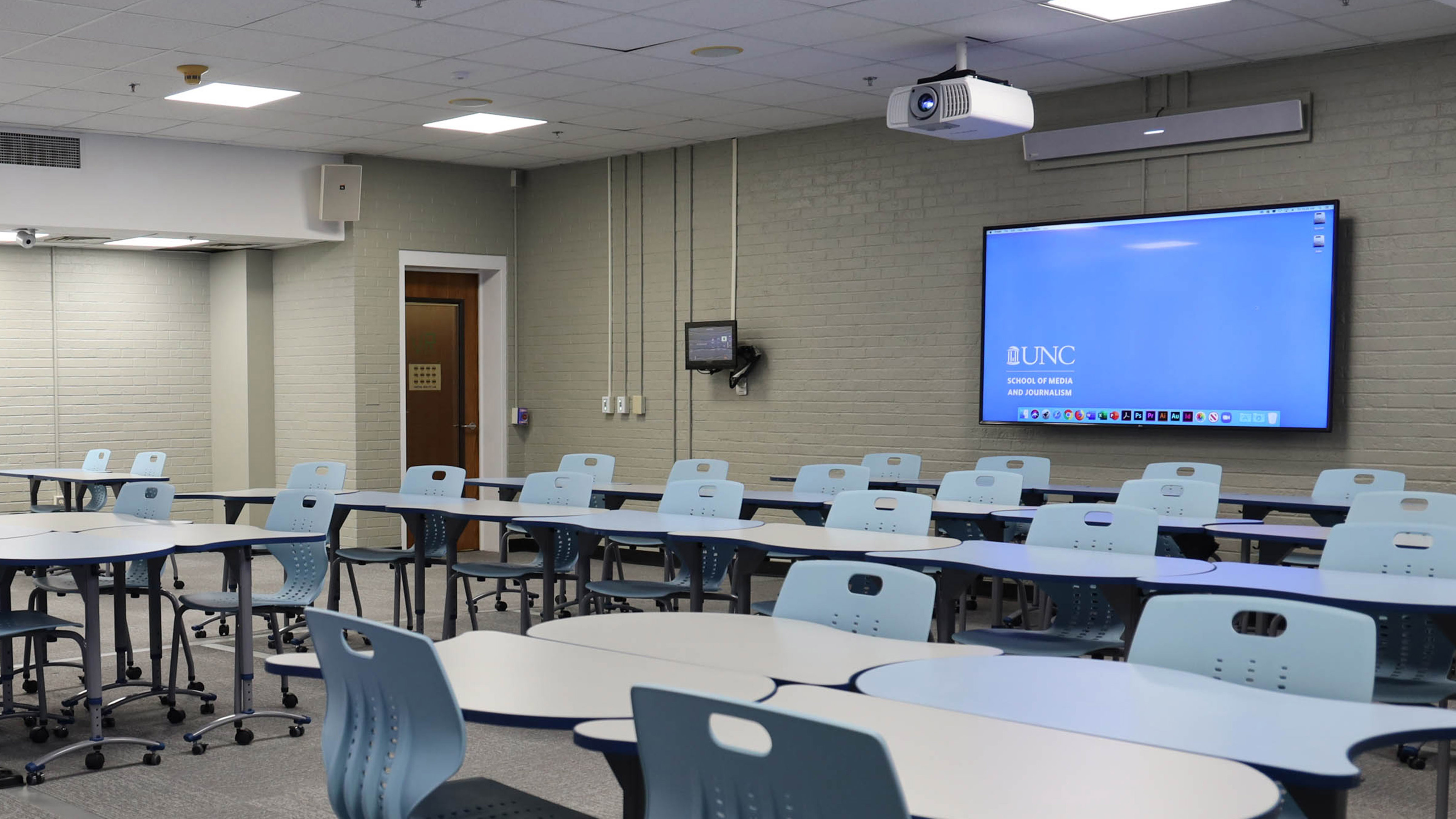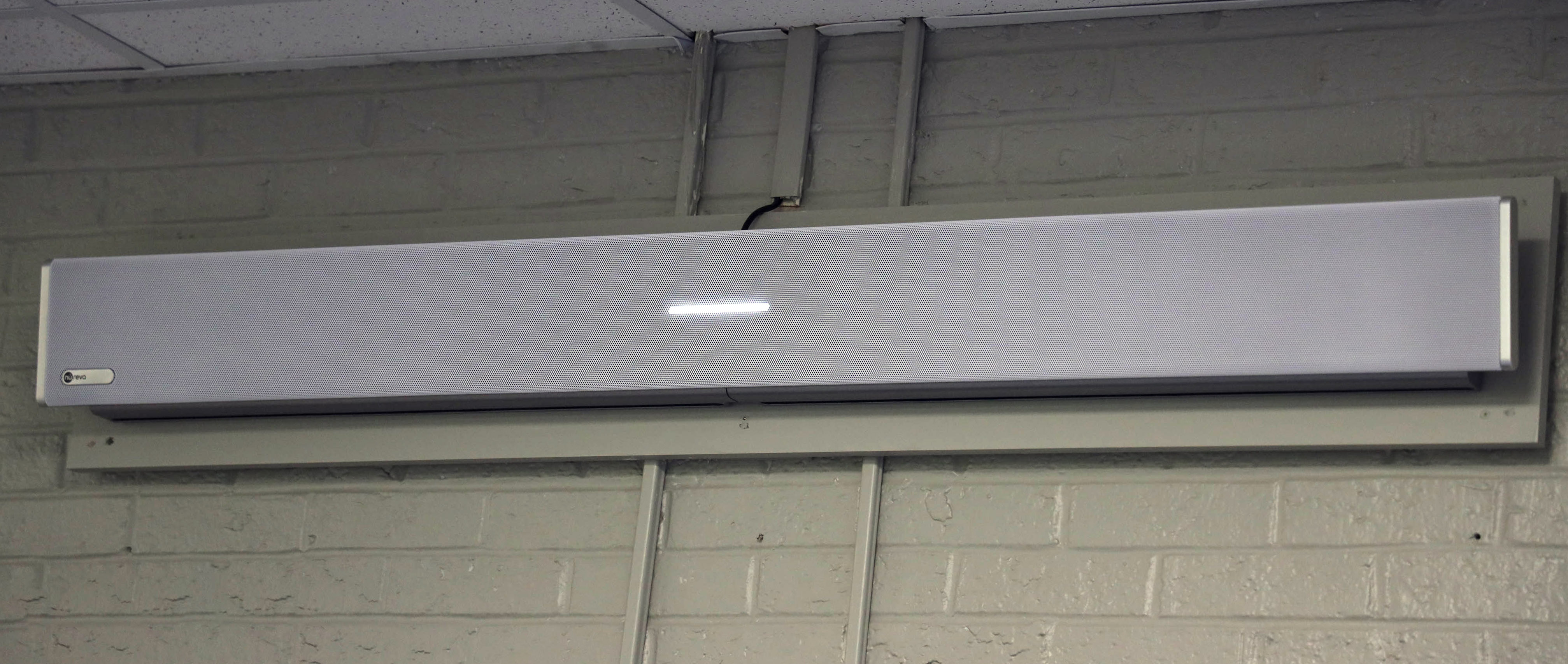UNC School of Journalism Adopts Nureva Audioconferencing Systems
The microphone-equipped soundbars, placed at the front of each classroom, provide consistent audio pickup for remote students.

One lasting impact of COVID-19 has been the acceptance of hybrid learning in college classrooms, with professors teaching a mix of on-premises and web-connected remote students at the same time. Ensuring an equal level of participation for both groups is a challenge, particularly when it comes to discussions in the physical classroom, because poor microphone placement can make it difficult for remote students to hear.

The University of North Carolina (UNC) Hussmann School of Journalism and Media in Chapel Hill, NC, has found a unique solution to audio pickup problems in its building. Eighteen of its classrooms have been equipped with Nureva HDL300 audioconferencing systems, with one of the microphone-equipped soundbars placed at the head of each classroom. Using a mix of 12 onboard physical omnidirectional microphones plus AI-driven level adjustments and control, the HDL300's "Microphone Mist" technology can provide consistent audio pickup through a 25-foot square room. (Two HDL300s can be combined to cover larger spaces.)
[North Carolina at Chapel Hill Opens Esports Arena]
“It’s like everybody in the room is wearing a microphone,” said Gary Kirk, broadcast engineer and classroom AV technician for the Hussman School of Journalism and Media. “I love that the AI that's built into this soundbar is constantly adjusting the acoustics and echo cancellation to provide consistent whole room coverage, with no actions being required by a human operator. It’s all automatic and hidden within the soundbar, and the result is clear, intelligible audio from anywhere in the space that can be understood by remote students at all times.”

In creating the HDL300, Nureva decided to take a "clean sheet" approach to the problem of consistent audio pickup. “The definition of this problem had always been expressed in terms of people seated around the table and how their audio could be best captured by physical microphones,” expalined Nancy Knowlton, president and CEO of Nureva. “As we started to think about how people would collaborate in a conference room setting, we conceived of them being much more actively involved physically within a space, with people standing at displays and moving around, and audio coming from all corners of the room. This is what inspired our Microphone Mist audio capture approach.”
[High Expectations for Hybrid Education]
Essentially, the Microphone Mist technology is built on the AI-driven assessment and control of inputs from the soundbar’s 12 physical microphones to create 8,192 virtual microphones. Each virtual microphone, or "pickup point," is created when two or more of the physical microphones in the HDL300 work together to focus sound pickup on a distinct zone. With Microphone Mist, each virtual mic is optimized for a natural listening experience.
A daily selection of features, industry news, and analysis for AV/IT professionals. Sign up below.
“With Nureva’s type of AI-controlled virtual microphones, you can direct a lobe to cover a particular area, typically defined in a classroom as a place where someone is sitting,” Knowlton said. “This is a capability not found in beamforming technology.”
The Hussman School is no newcomer to HDL300 sound bars. “We had piloted one of these several years ago and then were happy with the performance in one room,” said Kirk. “So, we built out a second classroom that had also included one of the Nureva HDL300s. Then, when the pandemic happened in 2020 and everybody went remote, we knew that the return would include some form of hybrid classroom that had to address the poor audio pickup problems being experienced by remote students. That’s why we increased our number of HDL300-equipped rooms to 18—and plan to add up to six more.”
[How Sony Cameras Are Changing the Game for University of Maryland Athletics]
Despite incorporating sophisticated audio pickup and processing technology, the HDL300 is simple to install. “Anyone can set this up: You don't have to be any kind of a tech genius,” Kirk said. “You don't even have to be very good mechanically: Put two screws into a wall at the front of the room and you can hang the thing up. And then you've got one cable that runs back to your hub/breakout box, which connects to your network using a standard USB connection.”
All told, Nureva’s HDL300 soundbars are precisely what the Hussman School was looking for to resolve its audioconferencing consistency issues. “Despite what people may think, it’s the audio that matters during multi-site sessions, not the video,” said Kirk. “That’s why consistent audioconferencing technology is so vital to what we’re doing in our hybrid classroom, and why the Nureva HDL300 soundbar is so central to our successful operation.”
James Careless is an award-winning freelance journalist with extensive experience in audio-visual equipment, AV system design, and AV integration. His credits include numerous articles for Systems Contractor News, AV Technology, Radio World, and TV Tech, among others. Careless comes from a broadcasting background, with credits at CBC Radio, NPR, and NBC News. He currently co-produces/co-hosts the CDR Radio podcast, which covers the Canadian defense industry. Careless is a two-time winner of the PBI Media Award for Excellence.

